May 15, 2023
Media Ignore Delhi’s Coldest May Since 1901
By Vijay Jayaraj
On May 4, India’s capital of New Delhi recorded the third coldest May morning since 1901. At 16 degree Celsius (60 Fahrenheit), the region’s 32 million residents woke up to a relatively cold morning in what is usually the hottest month of the year.

So why is there a record low temperature when the dominant mainstream narrative tells us that climate change has made our environs warmer than before? Is this just an aberration?
While Western media obsessed with the warm weather in Spain, India’s capital recorded a very cold summer morning. In fact, most of the cold-weather records in Delhi have gone unreported in Western media, which are mainly interested in showcasing the city’s extreme summer temperatures.
Neatly concealed from the public’s eye are the record low winter temperatures that Delhi has been witnessing since 2017. In December 2018, Delhi recorded an average minimum temperature of 7C (44F), the third lowest in the last 50 years. On December 30, 2019, the maximum temperature settled at 9C (49F), making it the coldest December day in 122 years.
As is the case globally, winter cold in Delhi is a bigger killer than summer heat. According to studies, short-term exposure to extreme temperature accounts for 6.5 percent of all deaths in India, with 88 percent of that amount caused by cold weather and only 12 percent by hot weather.
This is an example of media bias towards advancing a narrative of apocalyptic warming when reporting weather events. Also, part of this slanted reporting is the media’s failure to acknowledge the real reason behind the recording of all-time high summer temperatures: the urban heat island (UHI).
Urban Heat Island, Not Climate, Sets Records
During my stint as a climate consultant in New Delhi, I lived close to the Safdarjung temperature-measurement station. As per the Indian Meteorological Department, the highest maximum temperature ever recorded at Safdarjung was 47C (117F) on May 29, 1944.
This high temperature recorded nearly 80 years ago for this station has yet to be toppled by the 21st century warming that supposedly threatens us with doom, and the reason is probably the station’s location.
Unlike the other temperature monitoring stations in Delhi, the Safdarjung station is in a relatively greener section of the city. Thus, it is less susceptible to the Urban Heat Island effect, and, therefore, has not been registering the insanely high temperatures of 49C (120F) witnessed in and around Delhi.
Mahesh Palawat, vice-president of Skymet Weather Services, says, “Safdarjung weather station is located in a fairly green area, as compared to the rest of Delhi, which has a lot of heavily concretised spaces without much green cover. Temperatures in these parts of the city will therefore, understandably, be higher.”
So, the reason thermometers record new all-time highs in Delhi is because of urbanization’s concrete structures and pavements and other landscape changes. Weather officials also note that some of the newer automatic weather instruments used in highly urbanized areas may be prone to error.
“Most observatories in Delhi have automatic systems, which have a scope for error because they use bimetals, which can contract and expand during different weather conditions,” says an official of the India Meteorological Department in the Hindustan Times. He added that abnormal temperature spikes of the error-prone stations should be compared to the readings of older stations like Safdarjung to obtain “a more precise idea of the temperature.”
It takes just a bit of common sense to understand the artificial urban heat island impact on thermometers in cities and airports. However, preconceived notions of catastrophic warming pose serious hurdles to grasping this reality.
Delhi’s case illustrates that warming is not a continuous and unprecedented phenomenon as some claim it to be. Instead, we see at play a chaotic climate system at work with unpredictable weather patterns. Additionally, we must be mindful of the urban heat island impact when reading news bulletins about record-high summer temperatures.
Vijay Jayaraj is a Research Associate at the CO2 Coalition, Arlington, Virginia. He holds a master’s degree in environmental sciences from the University of East Anglia, UK and resides in India.
May 05, 2023
The Practical Impossibility of Large-Scale Carbon Capture and Storage!
By Steve Goreham-- May 2, 2023
"CCS has been slow to take off due to the cost of capture and the limited salability of carbon dioxide as a product. Thirty-nine CCS facilities capture CO2 around the world today, totaling 45 million tons per year, or about one-tenth of one percent (0.1%) of industrial emissions produced globally.”
The Environmental Protection Agency is working on a new rule that would set stringent limits on carbon dioxide (CO2) emissions from US power plants. Utilities would be required to retrofit existing plants with carbon capture and storage (CCS) technology or to switch to hydrogen fuel. Others call for the use of CCS to decarbonize heavy industry. But the cost of capture and the amount of CO2 that proponents say needs to be captured crush any ideas about feasibility.
Carbon capture and storage is the process of capturing carbon dioxide from an industrial plant before it enters the atmosphere, transporting it, and storing it for centuries to millennia. Capture may be accomplished by filtering it from combustion exhaust streams. Pipelines are proposed to transport the captured CO2. Underground reservoirs could be used for storage. For the last two decades, advocates have proposed CCS to reduce emissions from coal plants and steel, chemical, and other hard-to-decarbonize industries in order to fight human-caused climate change.
CCS has been slow to take off due to the cost of capture and the limited salability of carbon dioxide as a product. Thirty-nine CCS facilities capture CO2 around the world today, totaling 45 million tons per year, or about one-tenth of one percent (0.1%) of industrial emissions produced globally. Of these, 20 reside in the US or Canada, six in Europe, and five in China. Twenty-four of these facilities use captured CO2 for enhanced oil recovery. Captured CO2 is injected into oil wells to boost oil output,
The news from these facilities is mixed. Many are not meeting their carbon-capture goals or are incurring costs well over budget. Nevertheless, Australia, Canada, China, Japan, the US, and nations of Europe now offer billions in direct subsidies or tax breaks to firms for capture of CO2 emissions and to build pipelines and storage. Over 300 large and small capture projects are in planning around the world which, after completion, may be able to boost capture to 0.5 percent of man-made emissions.
Illinois, Iowa, and other states are struggling with issues involving plans for CO2 pipelines. Ethanol plants and other facilities propose to capture CO2 and need a new network of pipelines to transport the gas to underground storage sites. These pipelines face strong opposition from local communities over farmland use and safety concerns in the case of a pipeline rupture.
Carbon capture and storage is very expensive. An example concerns plans for CCS in Wyoming, the leading US coal state. Wyoming mined 41 percent of US coal in 2020 and coal-fired plants produced about 85 percent of the state’s electricity. With abundant coal resources and good opportunities to store CO2 underground, Wyoming appeared to be an excellent candidate to use CCS. The state passed House Bill 200 in March 2020, directing utilities to produce 20 percent of electricity from coal plants fitted with CCS by 2030.
In response to the statute, Rocky Mountain Power and Black Hills Energy, Wyoming’s two major power companies, analyzed alternatives for their operations and provided comments to the Wyoming Public Service Commission in March 2022. But the comments were not favorable for CCS. Black Hills Energy determined that adding CCS to two existing coal plants would cost an estimated $980 million, or three times the capital cost expended to build the plants. Rocky Mountain Power stated that adding CCS to its existing plants was “not economically feasible at this time.”
Beyond cost, the amount of carbon dioxide that advocates say must be captured is vast. The amount of CO2 produced by industry is small in global terms, only about five percent of what nature releases into and absorbs from the atmosphere every day. But the amount of industrial CO2 produced is still huge in human terms.
For example, an empty Boeing 747 jumbo jet weighs 412,300 pounds (187,000 kg). Its maximum fuel weight is 433,195 pounds (196,494 kg), more than the empty weight of the aircraft. During fuel combustion, two oxygen atoms are taken from the atmosphere and combined with each carbon atom. For each kilogram of jet fuel burned, 3.16 kilograms of carbon dioxide are created.
Consider the Drax Power Station in North Yorkshire, England, the third-largest power plant in Europe, which has been converted to using two-thirds biomass fuel. The plant is experimenting with CCS to reduce emissions. Each day, the plant uses about 20,000 tons of wood pellets delivered by 475 railroad cars. Picture the volume that these railroad cars would carry and then more than double it to get an idea of the amount of CO2 to be captured and stored each day.
The world’s heavy industries use vast amounts of coal, natural gas, and petroleum. Ammonia, cement, plastics, steel, and other industries produce billions of tons of materials each year for agriculture, construction, health care, industry, and transportation. Capturing, transporting, and storing CO2 from these processes would involve trillions of dollars and many decades of investment.
The International Energy Agency calls for 9 percent of the world’s CO2 emissions to be captured and stored by 2050. Today we have a mix of 39 major and minor capture facilities in operation. The IEA estimates that 70 to 100 major capture facilities will need to come online each year until 2050 to achieve this goal. It’s unlikely that even 20 percent of the goal will be achieved, despite hundreds of billions of dollars in spending.
--------
Steve Goreham, a popular speaker on energy, environmental, and public policy issues, is author of three books on energy, sustainable development, and climate change. His previous post at MasterResource was “Green Energy: Greatest Wealth Transfer to the Rich in History,”
Apr 08, 2023
History and Human Biology Argue for Warmth, not Cold
By Vijay Jayaraj
To those who have been misled to believe that a warming planet is dangerous, prepare to have a myth shattered: Data from hundreds of scientific journals across major publishing platforms and policy reports from major governments say cold is responsible for more deaths than hot weather worldwide.
Nonetheless, many people find it hard to believe this fact because of the decades-long propaganda and hysteria surrounding global warming. Here is why we should be thankful that our world is warming.
Human Body is Made for Warm Weather
Humans evolved in warm environments. The body is better equipped to handle heat than cold as it can regulate temperature through sweating and other mechanisms. However, in cold weather, our bodies must work harder to maintain a normal temperature, which can lead to a variety of health problems.
Anecdotes of heart attacks induced by shoveling snow are common in northern climes. When exposed to cold temperatures, the body’s blood vessels constrict to conserve heat, which can increase blood pressure and strain the heart.
The relative dryness of cold air is irritating to airways, causing inflammation and making breathing more difficult, particularly for those with preexisting respiratory conditions like asthma or chronic obstructive pulmonary disease (COPD).
So, it is no wonder that civilizations flourished when temperatures were higher, especially when home heating was primitive or nonexistent.
Lessons from Norse Farming in Greenland
Some of the earliest civilizations - such as those in Mesopotamia, Egypt, and the Indus Valley - developed in warm, arid regions with fertile soils and abundant water resources. They were able to support large populations that developed sophisticated technologies, such as irrigation systems that made agriculture possible in dry lands.
Warmer temperatures are associated with higher crop yields, particularly for plants like wheat, rice and maize. Greater warmth increases the length of the growing season and improves the rate of photosynthesis.
In contrast, colder regions like northern Europe and Asia were historically less hospitable to human populations. In these regions, food production was more difficult and the risk of famine and disease higher. The only time life in colder regions was favorable is when there were centuries-long warming phases.
An example of this is the Vikings who developed a thriving civilization in Scandinavia and grew food in Greenland during the Medieval Warm Period. Charred grains and waste from threshing grain proved that barley was cultivated in Greenland by medieval Norse farmers.
As summer and winter temperatures decreased with the waning of medieval warmth, Vikings abandoned farming and turned to seafood. “Greenland’s climate worsened during the Norse colonization,” says Eli Kintisch in “Science” magazine. “In response, the Norse turned from their struggling farms to the sea for food before finally abandoning their settlements.”
Kintisch continues, “It was a sustainable lifestyle for hundreds of years. But in the 13th century, economics and climate began to conspire against the Norse. After 1250, a cooling climate posed multiple threats to a marine-oriented society.”
Even in moderate parts of Europe, the 16th century Little Ice Age was horrific. “All things which grew above the ground died and starved,” reported the National Post.
“The cold was so extreme and the freeze so great and bitter, that nothing seemed like it in the memory of man,” recalls Pierre de l’Estoile, the diarist.
Then, a warming that began in the 17th century and continues to the present day restored more bountiful harvests and a measure of food security that allowed time and energy for innovation and the onset of the Industrial Revolution. Since then, the human population has increased 10-fold.
So, the notion that warming is killing the planet is false. In fact, it is dangerous to direct public policy toward reducing the global temperature.
This commentary was first published at BizPac Review, April 6, 2023..
Vijay Jayaraj is a Research Associate at the CO2 Coalition, Arlington, Virginia. He holds a master’s degree in environmental sciences from the University of East Anglia, UK and resides in India.
Apr 01, 2023
Southwestern states setting snow records in a brutal throwback winter!
Joseph D’Aleo, CCM
Mammoth Mountain ski area in California exceeded all-time snowfall record this past week. Mammoth Mountain surpassed its all-time record of snowfall this season with 702 inches recorded at the main lodge on Wednesday.
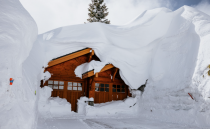
Enlarged
The resort says historical snowfall records are kept at the Main Lodge. The previous record was in the 2010/2011 La Nina season which had a total of 668 inches.
The mountain’s peak, which is at an elevation of 11,053 feet, received over 870 inches of snow this season, leaving a base depth of 336 inches as of Wednesday, March 29.
Unlike 2021/22 which had 1 big month, 2022/23 had 5 signifiant snow months, with 220 in January and 192 inches in March.
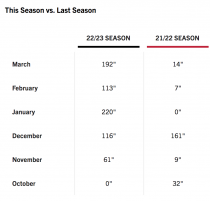
Enlarged

Enlarged
They expect ski lifts will be open to July.
Oh and the water level at Lake Oroville is 856.97 feet (95% of the max level 900 feet).

Enlarged
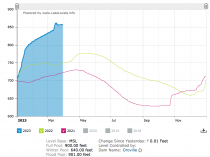
Enlarged
BTW KSL AND FOX 13 In Salt Lake City report Utah has set a state record for snowfall with well over 800 inches in Alta. Alta Ski Area has received more than 2.5 feet of snow since Thursday morning, pushing its seasonal total to over 800 inches early Friday morning. As of noon, 809 inches of snow, or more than 67 feet, of snow have fallen in the area since October. The resort’s previous record - since at least 1980 - was 748 inches, which was broken last week.
“This endless winter continues to produce staggering snow totals,” resort officials wrote on social media and on its website. “Alta has received some of the highest snowfall totals on the planet.”
Mar 17, 2023
California’s wild winter
By Joseph D’Aleo
The main lodge at Mammoth Mountain in California has reached 618 inches (more than 50 feet) for the season. The record was 668 inches in 2010/11. At the summit, the seasonal total is at 784 inches (over 65 feet)
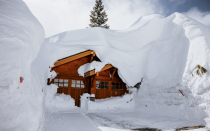
Enlarged

Enlarged
The last time the resort had this much snow was during the 2016/2017 season, making this the second snowiest season for Mammoth Mountain in the last 10 years.
The all-time record for the most snow at Mammoth Mountain was in the 2010/11 Season with 668 inches. The mountain does expect to break that record in the coming weeks.
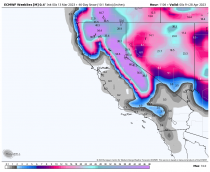
Enlarged
Meanwhile water levels in the reservoirs are rising fast.
Winter storms across California have significantly improved drought conditions and filled state reservoirs that had held less than a third of their capacity.
Drone photos from the California Department of Water Resources show just how big a difference a recent series of storms, brought on by 11 major winter storms has made.
The image below shows Lake Oroville in Butte County, California’s second-biggest reservoir. The first image was taken Dec. 21. The second image was taken Jan. 12, after several storms had begun to refill the reservoir. The last image was taken March 8 and shows a dramatic improvement in the water level.
In the first image, the lake was at just 29% of its capacity. In the second image, the level had jumped to 51%. And by the third photo, the figure was up to 75%.
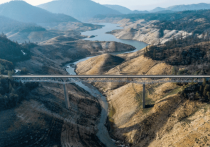
Enlarged
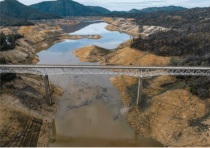
Enlarged
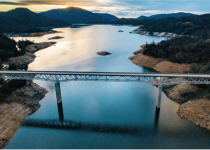
Enlarged
As of Tuesday, Folsom Lake was at 63% of its capacity, in line with the historical average level.
The winter storms have eased drought conditions across the state and prompted authorities to lift mandatory water restrictions for millions of Southern California residents.
This story originally appeared in Los Angeles Times.
Precipitation total forecasts to May 1:
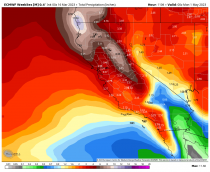
Enlarged
The trend since 1890 for winter precipitation is just -0.01 inch per decade with ups and downs.

Enlarged
|















